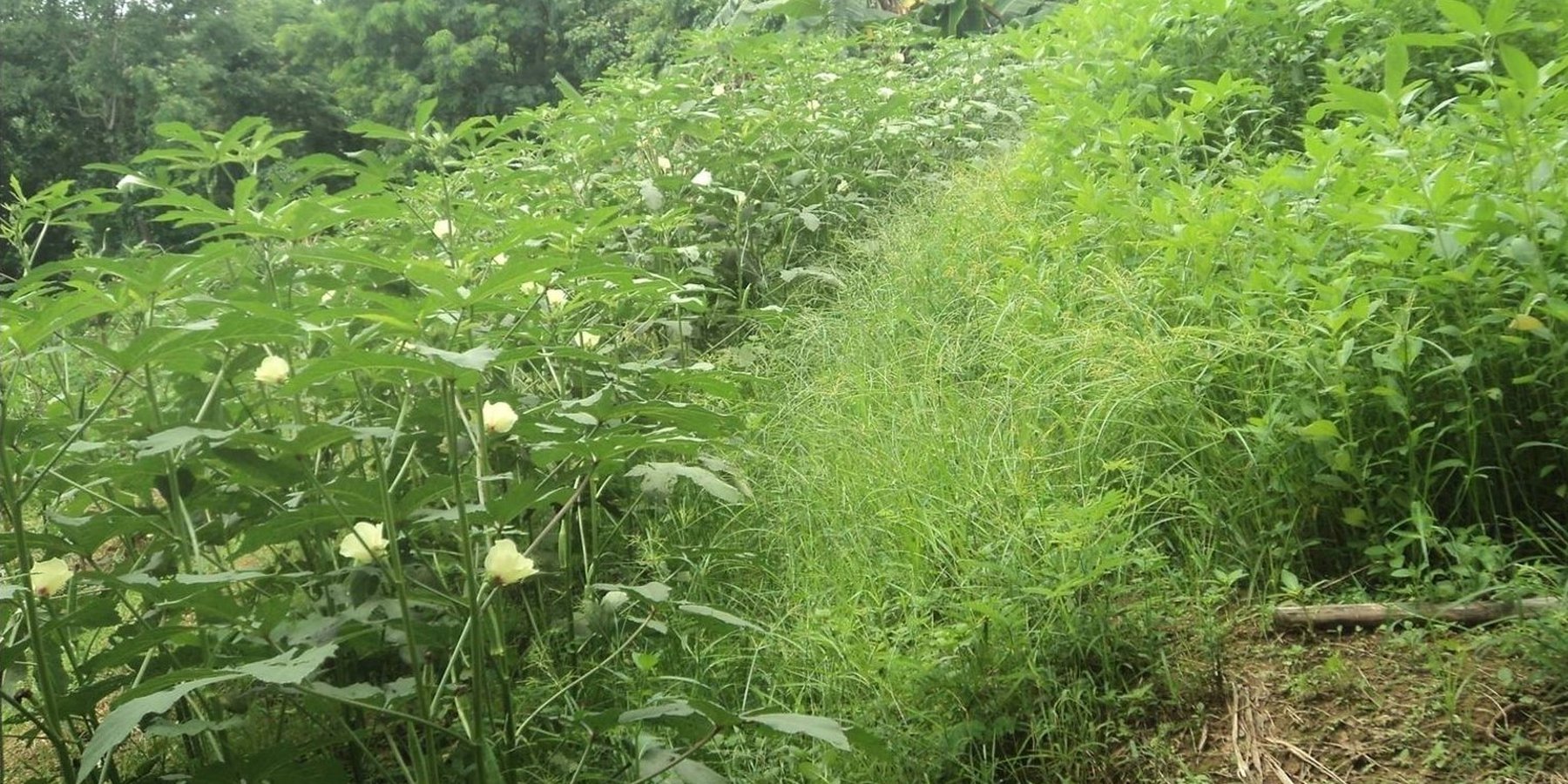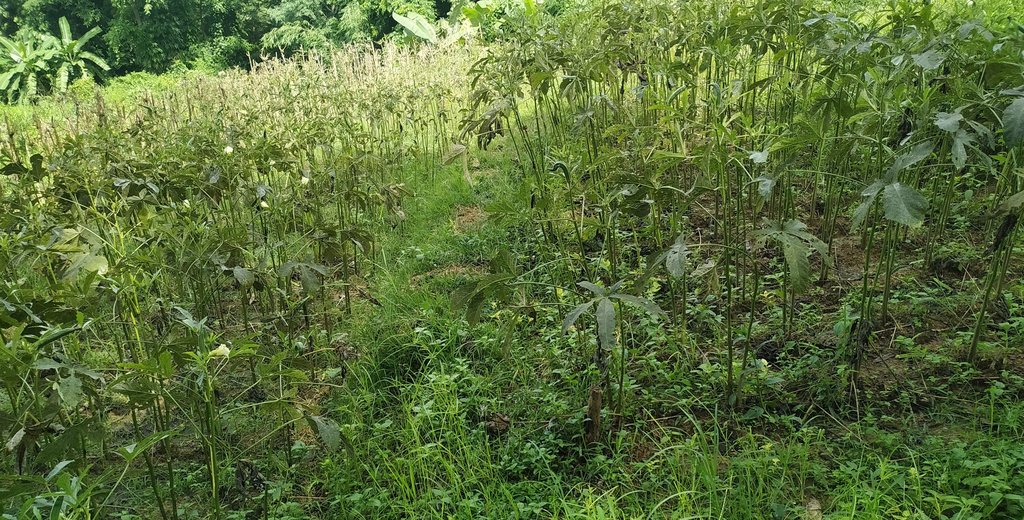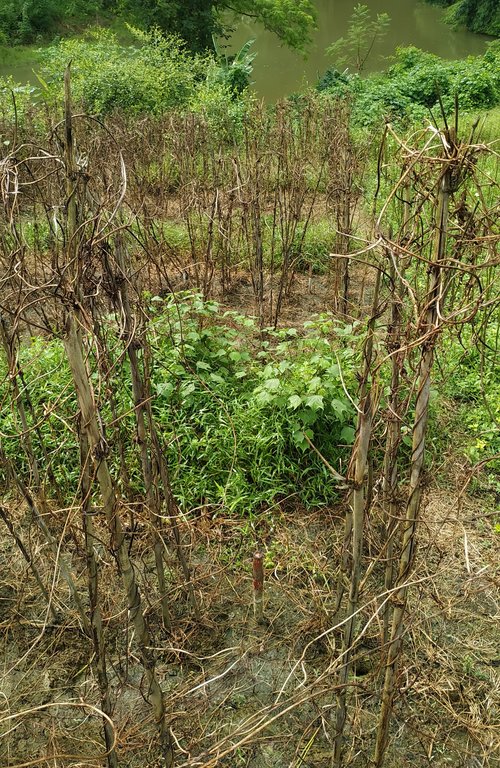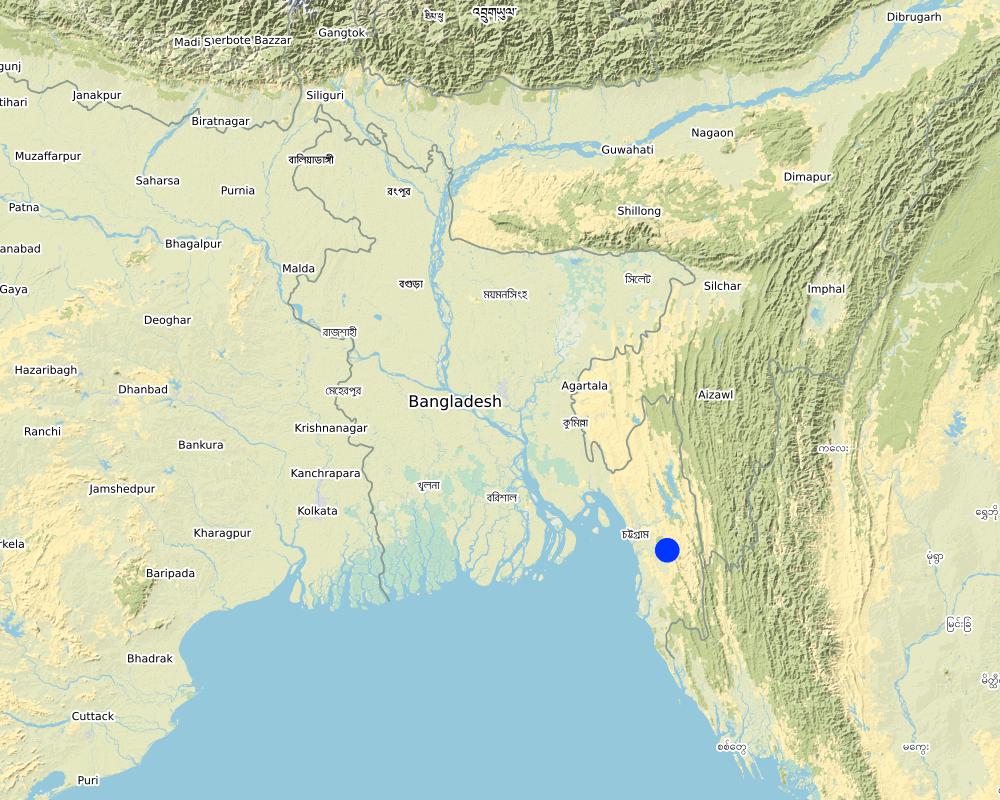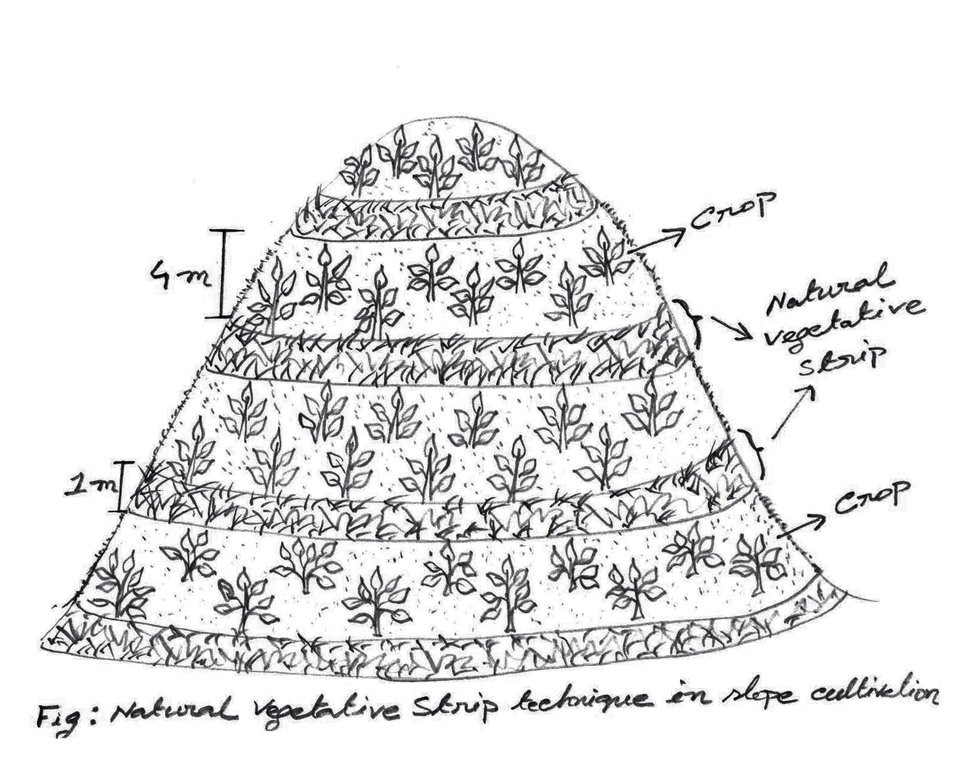Minimizing soil erosion through Natural Vegetative Strip (NVS) practice in slope cultivation [孟加拉国]
- 创建:
- 更新:
- 编制者: Fazlay Arafat
- 编辑者: –
- 审查者: Rima Mekdaschi Studer, Ursula Gaemperli
technologies_5504 - 孟加拉国
查看章节
全部展开 全部收起1. 一般信息
1.2 参与该技术评估和文件编制的资源人员和机构的联系方式
关键资源人
SLM专业人员:
Islam Md. Mahbubul
Soil Conservation and Watershed Management Center
孟加拉国
SLM专业人员:
Islam Md. Shahinul
Soil Conservation and Watershed Management Center
孟加拉国
有助于对技术进行记录/评估的项目名称(如相关)
Decision Support for Mainstreaming and Scaling out Sustainable Land Management (GEF-FAO / DS-SLM)有助于对技术进行记录/评估的机构名称(如相关)
FAO Bangladesh (FAO Bangladesh) - 孟加拉国有助于对技术进行记录/评估的机构名称(如相关)
Soil Resource Development Institute (SRDI) (Soil Resource Development Institute (SRDI)) - 孟加拉国1.3 关于使用通过WOCAT记录的数据的条件
编制者和关键资源人员接受有关使用通过WOCAT记录数据的条件。:
是
1.4 所述技术的可持续性声明
这里所描述的技术在土地退化方面是否存在问题,导致无法被认为是一种可持续的土地管理技术?:
否
2. SLM技术的说明
2.1 技术简介
技术定义:
Natural Vegetative Strips (NVS) are narrow strips of naturally growing grasses and herbs intentionally left unploughed along the contours of slope land to serve as buffers that prevent soil erosion during heavy rains.
2.2 技术的详细说明
说明:
The Chittagong Hill Tracts (CHT) covers an area about 13,181 km2 and occupies about 76% of total 12% upland areas of the country and is endowed with natural beauty and potential economic benefits. Shifting cultivation or jhum has been practiced in CHT for many hundreds of years by the local people. Shifting cultivation is a form of agriculture, in which an area of ground is cleared of vegetation, and cultivated for a few years and then abandoned for a new area until its fertility has been naturally restored. Many cultivators practice slash-and-burn in jhum as one element of their farming cycle. Shifting cultivation and its associated fires destroyed about two thirds of the previously existing forests in CHT, which has accelerated soil erosion. While it was an environmentally suitable land use in the past when population pressure was low, it has gradually become an environmentally incompatible land use system with the shortening of fallow periods. In addition to increasing population pressure, low investment in agricultural technology, and poor management of land rights have also negatively impacted the forests. One of the best ways of adapting to these issues is the adoption of Natural Vegetative Strip (NVS) technique on cultivated slopes.
NVS are narrow strips of naturally growing grasses and herbs intentionally left unploughed along the contours of hilly-sloped lands. On gentle slopes, every 4-meters a 1-meter wide strip of NVS is made along the natural contours of the slope. These strips serve as buffers that prevent the soil from eroding during heavy rains and intensive cultivation. Over time, these strips form stable terraces along the contours. Vegetables and other crops can be cultivated in between two NVS.
The Soil Conservation and Watershed Management Center in Meghla, Bandarban has implemented demonstration plots of this sustainable land management technique. Here the use of NVS has improved morphological and reproductive characteristics. They reduced soil erosion by more than 90% and NVS’s were easy to establish as they were incorporated during land preparation, and thus required minimal labour. They did not entail additional cost, as there was no need for additional planting materials, since the grasses naturally grew on the farm.
In addition to minimizing soil erosion, NVS plays a vital role in improving plant growth, crop productivity, and fruit length and weight. The strips also filter pesticides, nitrates and soluble phosphorus thus prevent runoff. As they improve water infiltration during heavy rains, subsequent land preparation and crop management become easier. One limitation of NVS is that it reduces the available cropping area by about 10 to 15%, depending on the steepness of the slope. The steeper slope require more wide vegetative strips for erosion protection. Typically the strips do not cause weed problems as long as the farmers regularly cultivate within the NVS area and maintain a 50 cm buffer around the area. If farmer-maintenance is good, no weed problems occur. NVS is a promising practice to mitigate soil erosion and improve crop cultivation in CHT.
2.3 技术照片
2.5 已应用该技术的、本评估所涵盖的国家/地区/地点
国家:
孟加拉国
区域/州/省:
Bandarban District
有关地点的进一步说明:
Soil Conservation and Watershed Management Center, Meghla, Bandarban
具体说明该技术的分布:
- 均匀地分布在一个区域
如果不知道精确的区域,请注明大致覆盖的区域:
- < 0.1 平方千米(10 公顷)
技术现场是否位于永久保护区?:
否
Map
×2.6 实施日期
如果不知道确切的年份,请说明大概的日期:
- 不到10年前(最近)
2.7 技术介绍
详细说明该技术是如何引入的:
- 在实验/研究期间
注释(项目类型等):
The Soil Conservation and Watershed Management Center demonstrate the NVS technology in hill slope of Bandarban area to study the impact of this practice on erosion.
3. SLM技术的分类
3.1 该技术的主要目的
- 改良生产
- 减少、预防、恢复土地退化
- 降低灾害风险
3.2 应用该技术的当前土地利用类型
同一土地单元内混合使用的土地::
否

农田
- 一年一作
年作 - 具体指明作物:
- 饲料作物 - 草
- 豆科牧草和豆类 - 豆子
- 蔬菜 - 其他
每年的生长季节数:
- 2
具体说明:
Summer and Winter
采用间作制度了吗?:
是
如果是,说明哪些作物是间作的:
Yard-long bean and Okra
采用轮作制度了吗?:
否
3.3 由于技术的实施,土地使用是否发生了变化?
由于技术的实施,土地使用是否发生了变化?:
- 否(继续问题3.4)
注释:
Shifting cultivation practiced in the slopes through slush and burn which triggered extreme soil erosion
3.4 供水
该技术所应用土地的供水:
- 混合雨水灌溉
注释:
Manual irrigation in the dry period from the stream
3.5 该技术所属的SLM组
- 横坡措施
3.6 包含该技术的可持续土地管理措施

植物措施
- V2:草和多年生草本植物
3.7 该技术强调的主要土地退化类型

土壤水蚀
- Wt:表土流失/地表侵蚀
3.8 防止、减少或恢复土地退化
具体数量名该技术与土地退化有关的目标:
- 减少土地退化
4. 技术规范、实施活动、投入和成本
4.1 该技术的技术图纸
技术规范(与技术图纸相关):
Slope: 15-45%
NVS width: 1 meter. Along the natural contours of the slope
Cropping bed: 4 meter
作者:
Nazrin Sultana
4.2 有关投入和成本计算的一般信息
具体说明成本和投入是如何计算的:
- 每个技术区域
注明尺寸和面积单位:
1 acre
如果使用本地面积单位,注明转换系数为1公顷(例如1公顷=2.47英亩):1公顷=:
1 acre = 0.4 ha
其它/国家货币(具体说明):
BDT
如相关,注明美元与当地货币的汇率(例如1美元=79.9巴西雷亚尔):1美元=:
84.0
注明雇用劳工的每日平均工资成本:
600 BDT
4.3 技术建立活动
| 活动 | 时间(季度) | |
|---|---|---|
| 1. | Cleaning | March-April |
| 2. | Making contour line | March-April |
| 3. | Planting | April-May |
4.4 技术建立所需要的费用和投入
| 对投入进行具体说明 | 单位 | 数量 | 单位成本 | 每项投入的总成本 | 土地使用者承担的成本% | |
|---|---|---|---|---|---|---|
| 劳动力 | Cleaning | person-days | 15.0 | 600.0 | 9000.0 | 100.0 |
| 劳动力 | Making contour line | person-days | 8.0 | 600.0 | 4800.0 | 100.0 |
| 劳动力 | Making pit | person-days | 8.0 | 600.0 | 4800.0 | 100.0 |
| 劳动力 | Fertilizer application | person-days | 2.0 | 600.0 | 1200.0 | 100.0 |
| 设备 | Spade, Knife, Basket | lump sum | 1.0 | 5000.0 | 5000.0 | 100.0 |
| 植物材料 | Seeds of vegetables | kg | 0.6 | 4000.0 | 2400.0 | 100.0 |
| 植物材料 | Bamboo stick to support plant | pcs | 1500.0 | 2.0 | 3000.0 | 100.0 |
| 肥料和杀菌剂 | Urea | kg | 450.0 | 16.0 | 7200.0 | 100.0 |
| 肥料和杀菌剂 | TSP | kg | 150.0 | 22.0 | 3300.0 | 100.0 |
| 肥料和杀菌剂 | MoP | kg | 200.0 | 15.0 | 3000.0 | 100.0 |
| 肥料和杀菌剂 | Cow dung | lump sum | 1.0 | 5000.0 | 5000.0 | 100.0 |
| 肥料和杀菌剂 | pesticides | lump sum | 1.0 | 2000.0 | 2000.0 | 100.0 |
| 施工材料 | Fencing | lump sum | 1.0 | 3000.0 | 3000.0 | 100.0 |
| 其它 | Transportation | Lump sum | 1.0 | 2000.0 | 2000.0 | |
| 技术建立所需总成本 | 55700.0 | |||||
| 技术建立总成本,美元 | 663.1 | |||||
注释:
The Soil Conservation and Watershed Management Center bear all the costs of this documented practice as land user
4.5 维护/经常性活动
| 活动 | 时间/频率 | |
|---|---|---|
| 1. | Maintenance of the natural vegetative strip (weeding the crop bed, repair the natural vegetative strip) | Before onset of the monsoon |
4.6 维护/经常性活动所需要的费用和投入(每年)
| 对投入进行具体说明 | 单位 | 数量 | 单位成本 | 每项投入的总成本 | 土地使用者承担的成本% | |
|---|---|---|---|---|---|---|
| 劳动力 | weeding the crop bed and repair the natural vegetative strip | person-days | 5.0 | 600.0 | 3000.0 | 100.0 |
| 技术维护所需总成本 | 3000.0 | |||||
| 技术维护总成本,美元 | 35.71 | |||||
4.7 影响成本的最重要因素
描述影响成本的最决定性因素:
The cost depends on the slope. Steep slopes require more natural vegetative strips to reduce soil erosion. Hence, the cost is higher for steep slopes.
5. 自然和人文环境
5.1 气候
年降雨量
- < 250毫米
- 251-500毫米
- 501-750毫米
- 751-1,000毫米
- 1,001-1,500毫米
- 1,501-2,000毫米
- 2,001-3,000毫米
- 3,001-4,000毫米
- > 4,000毫米
注明所考虑的参考气象站名称:
Bandarban
农业气候带
- 潮湿的
25.9 °C
5.2 地形
平均坡度:
- 水平(0-2%)
- 缓降(3-5%)
- 平缓(6-10%)
- 滚坡(11-15%)
- 崎岖(16-30%)
- 陡峭(31-60%)
- 非常陡峭(>60%)
地形:
- 高原/平原
- 山脊
- 山坡
- 山地斜坡
- 麓坡
- 谷底
垂直分布带:
- 0-100 m a.s.l.
- 101-500 m a.s.l.
- 501-1,000 m a.s.l.
- 1,001-1,500 m a.s.l.
- 1,501-2,000 m a.s.l.
- 2,001-2,500 m a.s.l.
- 2,501-3,000 m a.s.l.
- 3,001-4,000 m a.s.l.
- > 4,000 m a.s.l.
说明该技术是否专门应用于:
- 不相关
5.3 土壤
平均土层深度:
- 非常浅(0-20厘米)
- 浅(21-50厘米)
- 中等深度(51-80厘米)
- 深(81-120厘米)
- 非常深(> 120厘米)
土壤质地(表土):
- 中粒(壤土、粉土)
土壤质地(地表以下> 20厘米):
- 中粒(壤土、粉土)
表土有机质:
- 中(1-3%)
5.4 水资源可用性和质量
地下水位表:
5-50米
地表水的可用性:
好
水质(未处理):
不良饮用水(需要处理)
水质请参考::
地表水
水的盐度有问题吗?:
否
该区域正在发生洪水吗?:
否
5.5 生物多样性
物种多样性:
- 中等
栖息地多样性:
- 中等
5.6 应用该技术的土地使用者的特征
定栖或游牧:
- 定栖的
生产系统的市场定位:
- 商业/市场
非农收入:
- 低于全部收入的10%
相对财富水平:
- 平均水平
个人或集体:
- 员工(公司、政府)
机械化水平:
- 手工作业
性别:
- 女人
- 男人
土地使用者的年龄:
- 青年人
- 中年人
- 老年人
说明土地使用者的其他有关特征:
Normally land users will apply the Technology as households or small groups. In the case here documented, the Soil Conservation and Watershed Management Center in Bandarban applied the technology for research purposes
5.7 应用该技术的土地使用者使用的平均土地面积
- < 0.5 公顷
- 0.5-1 公顷
- 1-2 公顷
- 2-5公顷
- 5-15公顷
- 15-50公顷
- 50-100公顷
- 100-500公顷
- 500-1,000公顷
- 1,000-10,000公顷
- > 10,000公顷
这被认为是小规模、中规模还是大规模的(参照当地实际情况)?:
- 小规模的
5.8 土地所有权、土地使用权和水使用权
土地所有权:
- 州
- 社区/村庄
土地使用权:
- 社区(有组织)
- 租赁
用水权:
- 自由进入(无组织)
土地使用权是否基于传统的法律制度?:
是
具体说明:
As per Chittagong Hill Tract regulation act
5.9 进入服务和基础设施的通道
健康:
- 贫瘠
- 适度的
- 好
教育:
- 贫瘠
- 适度的
- 好
技术援助:
- 贫瘠
- 适度的
- 好
就业(例如非农):
- 贫瘠
- 适度的
- 好
市场:
- 贫瘠
- 适度的
- 好
能源:
- 贫瘠
- 适度的
- 好
道路和交通:
- 贫瘠
- 适度的
- 好
饮用水和卫生设施:
- 贫瘠
- 适度的
- 好
金融服务:
- 贫瘠
- 适度的
- 好
6. 影响和结论性说明
6.1 该技术的现场影响
社会经济效应
生产
作物生产
注释/具体说明:
Crop production increased as seeds are planted in a systematic way with proper spacing
饲料生产
注释/具体说明:
the natural strip yields fodder
非木材林业生产
注释/具体说明:
The natural strip can be potentially used for Broom grass cultivation
生产故障风险
注释/具体说明:
Each strip also act as a barrier for pest infestation
产品多样性
注释/具体说明:
Each strip can grow different types of crops
生产区域
注释/具体说明:
production area reduced due to establishment of natural strip
土地管理
水资源可用性和质量
灌溉用水需求
注释/具体说明:
Demand for irrigation water reduced as NVS reduces runoff and soil can hold more moisture
收入和成本
农业投入费用
注释/具体说明:
Cleaning and jungle cutting is not require for whole land. Thus it reduces cost.
农业收入
收入来源的多样性
注释/具体说明:
Non Timber Forest Product (NTFP) in natural strip also generates income
社会文化影响
食品安全/自给自足
娱乐机会
注释/具体说明:
The practice increase the aesthetic view
SLM/土地退化知识
生态影响
水循环/径流
地表径流
注释/具体说明:
Surface runoff reduces due to barriers of NVS
多余水的排放
地下水位/含水层
注释/具体说明:
Groundwater recharge improved due to reduced surface runoff
蒸发
土壤
土壤水分
土壤流失
土壤堆积
注释/具体说明:
Soil accumulation increased and eventually formed terraces along the contour line
养分循环/补给
土壤有机物/地下C
生物多样性:植被、动物
生物量/地上C
植物多样性
有益物种
栖息地多样性
害虫/疾病控制
减少气候和灾害风险
滑坡/泥石流
碳和温室气体的排放
6.2 该技术的场外影响已经显现
水资源可用性
温室气体的影响
6.3 技术对渐变气候以及与气候相关的极端情况/灾害的暴露和敏感性(土地使用者认为的极端情况/灾害)
渐变气候
渐变气候
| 季节 | 增加或减少 | 该技术是如何应对的? | |
|---|---|---|---|
| 年温度 | 增加 | 好 | |
| 季节性温度 | 夏季 | 增加 | 好 |
| 年降雨量 | 增加 | 好 | |
| 季雨量 | 湿季/雨季 | 增加 | 好 |
气候有关的极端情况(灾害)
气象灾害
| 该技术是如何应对的? | |
|---|---|
| 局地暴雨 | 好 |
| 局地雷暴 | 好 |
气候灾害
| 该技术是如何应对的? | |
|---|---|
| 干旱 | 适度 |
| 陆地火灾 | 适度 |
生物灾害
| 该技术是如何应对的? | |
|---|---|
| 昆虫/蠕虫侵扰 | 适度 |
6.4 成本效益分析
技术收益与技术建立成本相比如何(从土地使用者的角度看)?
短期回报:
稍微积极
长期回报:
非常积极
技术收益与技术维护成本/经常性成本相比如何(从土地使用者的角度看)?
短期回报:
积极
长期回报:
非常积极
6.5 技术采用
- 单例/实验
在所有采用这项技术的人当中,有多少人是自发的,即未获得任何物质奖励/付款?:
- 0-10%
注释:
The Soil Conservation and Watershed Management Center, Bandarban applied the technology for research purposes and found that the practice reduces up to 90% soil erosion in slope cultivation. The department of agricultural extension now planning to start piloting the practice in hill areas.
6.6 适应
最近是否对该技术进行了修改以适应不断变化的条件?:
否
6.7 该技术的优点/长处/机会
| 土地使用者眼中的长处/优势/机会 |
|---|
| Natural Vegetative strips are easy to establish. They are incorporated during land preparation, and thus require minimal labor. |
| They do not entail additional cost as there is no need for additional planting materials. |
| The natural strip reduces top soil erosion and retain the soil fertility. |
| 编制者或其他关键资源人员认为的长处/优势/机会 |
|---|
| The natural strips filter pests and also acts as a barrier to fire. |
| The natural strips eventually formed terraces for crop cultivation. |
| The practice improve water infiltration during heavy rains. |
6.8 技术的弱点/缺点/风险及其克服方法
| 土地使用者认为的弱点/缺点/风险 | 如何克服它们? |
|---|---|
| The NVS reduces the available cropping area by about 10 to 15%. | Non timber forest products like Broom grass can be planted in the natural strip to generate additional income to the farmers |
| Farmers regularly need to maintain the weeds of natural strip otherwise it may spread in the productive areas and reduces crop yield. | If farmer-maintenance is good, no weed problems occur |
| 编制者或其他关键资源人员认为的弱点/缺点/风险 | 如何克服它们? |
|---|---|
| Steep slope requires more wide natural vegetative strips and reduces the production area | Eventually the NVS formed wide bench terrace and allow more space for cultivation |
7. 参考和链接
7.1 信息的方法/来源
- 实地考察、实地调查
Number of informants: 02
- 与SLM专业人员/专家的访谈
Number of informants: 03
- 根据报告和其他现有文档进行编译
Number of report: 01
(现场)数据是什么时候汇编的?:
02/09/2019
7.2 参考可用出版物
标题、作者、年份、ISBN:
Annual report 2018-2019, SOIL CONSERVATION & WATERSHED MANAGEMENT CENTER (SCWMC), SOIL RESOURCE DEVELOPMENT INSTITUTE (SRDI)
可以从哪里获得?成本如何?
MINISTRY OF AGRICULTURE, GOVERNMENT OF THE PEOPLE’S REPUBLIC OF BANGLADESH
7.4 一般注释
The questionnaire addressed all the key aspects of the technology
链接和模块
全部展开 全部收起链接
无链接
模块
无模块


